3
The Creation of the National Academy of Medicine1
On April 28, 2015, Ralph Cicerone, then the president of the National Academy of Sciences (NAS), announced that “today the membership of the National Academy of Sciences voted to change the name of the Institute of Medicine [IOM] to the National Academy of Medicine [NAM].” The announcement marked the end of a concentrated, 2-year campaign to reconstitute the IOM as the NAM, conferring a new structure and authority parallel to that of the NAS and the National Academy of Engineering (NAE). As described in Chapters 1 and 2, the campaign was by no means the first attempt to transform the IOM into an Academy; indeed, the notion had persisted in some form for nearly five decades.
Cicerone’s announcement detailed, in part, the rationale that had fueled the campaign for so long. The addition of the new Academy would bring greater harmony to the work of the broader organization, which was rebranded at the same time as the National Academies of Sciences, Engineering, and Medicine (the National Academies).2 Continual advances in science, engineering, and medicine over the past 50 years meant that scientific inquiry was increasingly multidisciplinary, Cicerone explained. Solutions to society’s most pressing challenges required “knowledge, techniques, and tools from multiple areas of expertise.” The reorganization would provide a more unified organizational and governance structure and encourage expanded collaboration across the three Academies. It would create what Cicerone described as “a greater symmetry in the roles, scope of activities, and responsibilities within the organization.”3
As a result of the reorganization, the NAM gained co-equal status with the NAE in overseeing the joint program of the National Academies, including what had once been separately administered by the IOM. Indeed, achieving these goals meant a near-total reconfiguration of the IOM’s programs and profoundly changed the way the organization conducted its work. During the reorganization,
___________________
1 Except where otherwise noted, historical facts presented in this chapter are drawn from a 1998 history of the Institute of Medicine authored by Edward Berkowitz (IOM, 1998a).
2 Concurrent with the IOM/NAM rebranding, the name “National Research Council,” which had described the operating arm of the National Academy of Sciences and the National Academy of Engineering until 2015, was supplanted publicly by the “National Academies of Sciences, Engineering, and Medicine.”
3 Ralph J. Cicerone to National Academies staff, April 28, 2015, IOM/NAM Records.
the IOM’s activities were divided between the NAM and a new NRC programmatic unit called the Health and Medicine Division (HMD). Ongoing consensus studies and most convening activities (e.g., boards, as well as forums and roundtables, which also housed around 20 Action or Innovation Collaboratives) of the former IOM were moved to HMD, while membership activities, fellowships, awards, and select program activities remained with the NAM (see Chapter 3 Appendix Figures 3A-1 through 3A-4).
As the NAM defined its new purpose and role within the National Academies, it quickly expanded its programmatic portfolio and field leadership activities. Innovative collaborations, international outreach, and novel program models became hallmarks of the NAM’s approach during its first 5 years. Chief among its priorities was establishing a productive working relationship with HMD to carry forward the IOM’s legacy.
HISTORY OF CAMPAIGNS TO ESTABLISH THE NATIONAL ACADEMY OF MEDICINE
The campaign to create the NAM had been derailed several times in the past, due largely to an inability to agree on its role and scope within the larger institution. The IOM leaders who decided to renew the campaign in 2012 needed to incorporate the lessons of prior attempts that had met resistance and ended in failure. Although conditions and attitudes had changed over time, and the organization seemed to be ready for a new chapter, many past obstacles remained relevant.
The IOM had begun operations in 1970 as part of the NAS, and that affiliation had both advantages and disadvantages for the organization. The NAS’s scientific authority and reputation as an impartial adviser extended to the IOM, easing early efforts to mount new studies and establish a presence in Washington, DC. As an institute, rather than an Academy, the IOM was able to initiate its own studies, and it had more leeway to set its own priorities, allowing the organization to pursue an agenda that included social dimensions beyond the limitations of traditional medical research in the 1960s and 1970s. Walsh McDermott, one of the IOM’s founders, strongly believed in the IOM’s social mission and was a proponent of selecting members from outside the medical sciences. Despite these advantages, the IOM’s governance was only semi-autonomous. The IOM was not able to select its own president; rather, it was required to present candidates to the NAS president, who made the ultimate decision. The IOM’s association with the NAS also subjected the organization and its decisions to the scrutiny of the governing council of the NAS and the National Research Council (NRC, the operating arm of the National Academy of Sciences and the National Academy of Engineering until 2015), never allowing for complete independence.
The Sproull Report, 1984
The question of an Academy versus an Institute had been one of the central questions around the IOM’s founding (see Chapter 1). Fourteen years later, the first formal proposal to reconstitute the IOM as an Academy emerged when a group of foundations, led by Robert Ebert, president of the Milbank Memorial Fund, commissioned a study of the IOM’s structure and performance. As described in Chapter 2, a committee headed by physicist Robert Sproull undertook the review.
What became known as the “Sproull report” called for “a strengthening of the IOM that amounts to a rebirth”—in other words, its transformation into a fully autonomous and prestigious academy positioned to lead the nation’s response to health and medical challenges. To allow for this expanded leadership capacity, Sproull’s committee recommended that the IOM’s existing program of consensus studies be moved to an NRC division.
However, many members of the IOM’s governing council believed that implementation of the latter recommendation would compromise the founders’ design for a proactive, working organization. At its January 1985 meeting, therefore, the Council announced its preference to maintain
the IOM’s current name and structure. However, the final decision rested with the NAS Council. The following month, then-IOM President Frederick Robbins argued passionately before the NAS Council against implementation of the Sproull recommendations, claiming that the report betrayed “a true lack of support for the concept of the IOM.” Robbins was persuasive, to a point; his term as president was soon to conclude, and the NAS Council deferred any decision until the arrival of his successor. However, as described in Chapter 2, Samuel Thier focused on using the Sproull report’s expressed support for the IOM to solidify financial and institutional support for the institute in its existing form.
A Second Campaign Fails, 1994–1996
After nearly a decade, the question of transforming the IOM into an Academy arose once again—this time as an internally driven campaign. On July 6, 1994, as the IOM approached its 25th anniversary, then-President Shine wrote to NAS President Bruce Alberts, seeking his advice on asking the NAS Council to approve a name change to the National Academy of Medicine. Shine emphasized that the change would only affect the IOM’s name and not its mission or operations. He argued that “Institute of Medicine” created confusion with the National Institutes of Health (NIH), and that the relationship between the NAS and the IOM was not always clear, particularly when the NAE was added to the mix. Shine saw a name change as a way of matching the organization’s title to its work and as an appropriate way to celebrate the institute’s maturity and influence after 25 years.
Alberts replied positively to the proposal and put the matter before the NAS Council in August 1994, receiving favorable feedback. However, the NAS Council noted that proper procedure would have to be followed to effect the change—a process that would take 2 years when combined with the IOM’s own requirements.4 Approval required a two-thirds majority vote by the NAS membership, because the change would involve an amendment to the NAS charter. The NAS Council would have to approve a charter amendment ballot, with a return deadline of February 1995. Then the Council would present the recommended name change to the NAS members at their regular April 1995 meeting. The NAS membership would vote on the name change in 1996.5
Prior to initiating the NAS approval process, IOM members needed to provide their approval of the proposal. A ballot was sent to members in January 1995, accompanied by a letter from Shine that listed the reasons he favored the change. “We are an academy, not an institute,” he argued. Institutes carried out research, whereas an academy consisted of a “collection of learned individuals seeking to further art, science, or literature.” The term “academy” better described what the IOM did, Shine contended. Counterpart organizations throughout the world typically carried the title of “academy,” or, in some countries, royal societies. If the IOM changed its name to the National Academy of Medicine, Shine argued, it would be recognized “almost immediately as to who we are and what we do.” Shine emphasized that the name change implied “no other change in the mode of operation, representation, organization or participation of the Institute within the National Academy of Sciences or the National Research Council.”6
IOM members endorsed the name change with a vote of 380 in favor, 14 opposed, and 3 abstentions. However, by this time, some fissures had started to develop in support for the name change in the broader NAS complex. The NAE argued that, if the new NAM were to be allowed to maintain its independent program of studies, then the NAE should be given the same allowance (rather than its current limitation of carrying out studies through the NRC). Furthermore, at a regional meeting, NAS members expressed concern that they did not know enough about the
___________________
4 Kenneth Shine to Bruce Alberts, July 6, 1994, IOM/NAM Records; IOM Council Minutes, October 18, 1994, IOM/NAM Records.
5 IOM Council Minutes, January 10, 1995, IOM/NAM Records.
6 Kenneth Shine to IOM Members, January 17, 1995, IOM/NAM Records.
IOM or its operations to vote on the matter. In response to NAS members’ concerns, Alberts asked the IOM to prepare material that would make its case. He did not feel he could bring the proposal forward until the NAS membership could be “further educated.”7
Complicating the situation, the NAE faced internal tensions with the NAS and the NRC. The new NAE president was not nominated through the usual channels but rather ran as a “petition” candidate on a platform opposing the “NAE establishment.” When he took office in 1995, he directly criticized and challenged the NAS and the NRC. For example, he felt that the NRC’s work was not focused on important topics of the time and that its operations were too heavily influenced by staff members. He wanted the NAS to be able to lobby for the positions it supported—a proposal that was in direct violation of the institution’s tax-exempt, nonprofit status. The fraught interactions between the NAS and the NAE at this time overshadowed the discussion of the IOM’s name change and dampened some of the support for the change.8
Meanwhile, the IOM proceeded with its campaign to educate the NAS membership about the institute and its body of work. The campaign cited 12 reports that illustrated the nature of the IOM’s work and its considerable impact, including the report Preventing Low Birthweight (IOM, 1985) and the study on Confronting AIDS: Directions for Public Health, Health Care, and Research (IOM and NAS, 1986). The IOM also highlighted its convening activities, such as the recently initiated National Roundtable on Health Care Quality. The institute also submitted a statistical analysis of its membership for consideration by NAS members, noting that 17 percent of IOM members also belonged to the NAS and an overwhelming number of the members were either physicians or had doctorates.9
On April 2, 1996, Alberts sent NAS members a letter that contained a simple wording change to the NAS Constitution. The change substituted the words “national academy” for “institute” in Section 10, establishing the “National Academy of Medicine … as a separate membership organization under terms of a charter adopted by the Council of the National Academy of Sciences.” The NAS Council recommended that the change be approved by NAS leadership at that annual business meeting and that the membership consider it over the ensuing year, with a final vote at the 1997 business meeting.
To inform the NAS members’ decision, the letter from Alberts contained two short statements—one in favor of the name change and the other against. The supporting statement repeated the arguments already presented by Shine and the IOM Council. The statement against the change argued that the name change implied a fundamental shift in “the nature of the organization.” The IOM was established not to honor excellence in medicine but rather to respond to challenges for human health. It differed from the NAE, which was an “autonomous organization” and a partner in managing the NRC. Because the proposal did not include amendments to the IOM’s operating structure or status within the National Academies, the NAS would remain as the parent body of the National Academy of Medicine and continue to appoint its president. The statement indicated that these differences would lead to an institutional asymmetry that was likely to become a problem in the future.10
Some NAS members believed it was important to maintain the distinction between an institute and an academy. Frank Westheimer, a Harvard chemist, maintained that the IOM had a very dif-
___________________
7 Kenneth Shine to Colleagues, March 17, 1995, IOM/NAM Records; IOM Council Minutes, April 17–18, 1995, IOM/NAM Records.
8 IOM Council Minutes, April 17–18, 1995, IOM/NAM Records; IOM Council Minutes, July 18, 1995, IOM/NAM Records.
9 Kenneth Shine, “Name Change for the Institute of Medicine,” Draft Statement, November 21, 1995, IOM/NAM Records.
10 Bruce Alberts to NAS Members, April 2, 1996, with enclosures “Proposed Change to the Constitution to Change the Name of the Institute of Medicine to the National Academy of Medicine,” “Statement Against Changing the Name of the Institute of Medicine to the National Academy of Medicine,” “Statement in Favor of Changing the Name of the Institute of Medicine to the National Academy of Medicine,” NAS-NRC Archives.
ferent mission from that of the NAS, and that its members were elected on a very different basis. Once the IOM became the NAM, according to Francis Moore, the surgeon-in-chief emeritus at the Peter Bent Brigham Hospital, it would “immediately lose its functional status and become a mere honorary society.” Moore also pointed out that the multidisciplinary membership of the IOM, which included nurses, lawyers, pharmacists, and hospital administrators, would be lost in an academy. Neither the NAS nor the NAE had the “broad social contract and the responsibility for improvement of services to the public” of the IOM.11 Joint IOM/NAS members, many with senior status within the Academies, made what Alberts described as “passionate statements” against the name change. They believed that the IOM was doing so well that nothing needed to change.
Shine rebutted these various arguments, saying that the IOM had already established itself in both an honorific role and a service role. The existing IOM charter prevented it from becoming a purely honorific society, and no amendments to the charter were being proposed with the suggested name change.12 Therefore, the IOM would continue its operations as it had for the past 25 years.
Although many NAS members objected to the name change, there were some supporters. Maurice Hilleman, Director of the Merck Laboratory for Therapeutic Research, said he would support the name change. The NAS, he explained, had a basic science base and tended to recruit people in basic research who might become Nobel laureates. This practice left little room for the applied aspects of medicine and public health, which he believed also deserved representation in the National Academies.
Ultimately, on April 30, 1996, the NAS members voted against changing the IOM’s name to the National Academy of Medicine, and the debate over creating an academy of medicine fell dormant once again. Cicerone attributed the proposal’s defeat to the ongoing controversy with the NAE and a prevalent belief that the word “academy” carried a connotation that would fundamentally change the nature of the IOM. Reporting on the outcome, Shine urged his members to “continue our efforts to improve the quality, relevance, and responsiveness of our work…. Who knows what will happen with our name in 21st century?”13
In this effort, as in previous efforts to create an Academy, the timing mattered. Internal disputes with the NAE changed the climate in which the vote on the IOM’s name change occurred. Another retrospective lesson from this effort was that McDermott’s vision for the IOM, one in which the IOM served as an honorific organization also able to initiate its own studies and focus on social aspects of health (in part), had remarkable staying power. The generation that founded the IOM stood by this vision and was reluctant to let it go. Change also came hard to the NAS, which was steeped in tradition and regarded itself as a defender of science. At the time, it was difficult for NAS members to see how the IOM, an organization that put social change on its agenda, could be granted equal footing with the “hard” sciences.
SUCCESS OF THE 2013–2015 CAMPAIGN
Despite this setback, the IOM steadily built its reputation for influence and produced some of its most authoritative work in years following Shine’s campaign to change the name of the institute. The issue remained quiet until 2013, when a draft report titled How to Better Consolidate and Align the Constituent Parts of the National Academies and Strengthen Its Identity circulated among the NAS, NAE, and IOM Councils. The 2013 draft coincided with the 150th anniversary of the
___________________
11 Francis D. Moore to Kenneth Shine, March 22, 1996, IOM/NAM Records.
12 Kenneth Pitzer to Bruce Alberts, February 5, 1996, NAS-NRC Archives; Maurice Hillerman to Karen Hein, February 9, 1996, IOM/NAM Records; Francis D. Moore to Kenneth Shine, March 22, 1996, IOM/NAM Records; F. H. Westheimer to Peter Ravens, Home Secretary, NAS, April 2, 1996, NAS-NRC Archives.
13 Kenneth Shine to IOM Members, May 22, 1996, IOM/NAM Records; Bruce Alberts to Kenneth Shine, May 17, 1996, IOM/NAM Records.
NAS, a significant milestone for the organization. Although the NAS represented a stable institution that had maintained the essence of its mission, it had undergone significant changes over the course of its existence. For example, the NRC was added to the organization in 1916, the NAE was established in 1964, and the IOM followed in 1970. A provision implemented in the 1950s made the NAS president the chair of the NRC, ending years of tension between the two organizations. Now, approaching its milestone anniversary, NAS leadership reflected on the Academy’s history and organization with greater openness to changes in its structure. The intended goal of the 2013 report was to establish a rebranded “National Academies of Sciences, Engineering, and Medicine,” resulting in a unified, more consistent program. If such a change were enacted, the IOM would attain “comparable standing as an academy,” and its programmatic work would endure within a new division of the National Academies.14
This campaign differed from previous efforts in that, from the beginning, it was presented as a way to rationalize the National Academies’ entire structure, rather than as simply a name change for the IOM. It also was framed as a major reorganization of the NAS on the occasion of its 150th anniversary, rather than an IOM-centric request that would benefit a single arm of the institution. The atmosphere across the NAS complex also appeared to be different. Many of the prominent issues between the NAE and the NAS in the 1990s had been resolved. In fact, the NAE Council passed a resolution that “enthusiastically” supported the 2013 report. Additionally, with the passage of time, a new generation of IOM leaders was able to pursue change without the pressure of historical bonds and tradition outweighing the advantages of the new proposal.15
Following preliminary approvals, the NAS and its leadership continued to lead the reorganization effort. In June 2013, Cicerone, NAE President Charles Vest, and IOM President Harvey Fineberg appointed a committee to examine and update the draft document describing the NAS’s reorganization. The committee was chaired by joint IOM/NAS member Rick Lifton, who was both a distinguished scientist and an accomplished physician, and was further composed of representatives from across the National Academies. In creating the committee, Cicerone, Vest, and Fineberg indicated that the organization would welcome the committee’s advice on whether and how the NAS should evolve “so as to continue to provide the highest service to the nation.” They reported that the joint Councils of the NAS, the NAE, and the IOM had already discussed the draft proposal and expressed their enthusiasm for the concepts that were described in the document. Cicerone hoped that the committee would refine the draft document, identify potential risks and challenges that might arise during implementation, and outline the necessary steps to inform the members of the three constituent Academies and gain their support and approval.16
Lifton’s eight-person group, known as the Joint Governance Committee (JGC), deliberated through the summer of 2013 and reported back to the NAS, the NAE, and the IOM Councils at the end of September. The committee’s report represented a careful assessment of the draft report and its implications by a group with representation from all three of the affected entities (NAS, NAE, and IOM)—an invaluable step that had been overlooked in previous efforts. The members of the JGC carefully reviewed previous reorganization attempts and made a concerted effort to avoid repeating what it viewed as mistakes of the past. Based on the previous attempt under Shine’s presidency, the committee concluded that the greatest hurdle would be the vote among the NAS membership. That debate had centered on whether the IOM met the definition of an Academy. The JGC tried to avoid repeating this discussion by preparing a direct response to the question as part
___________________
14 “A Proposal to Better Consolidate and Align the Constituent Parts of the National Academies and to Strengthen Its Identity,” Draft for Discussion by the NAS, the NAE, and the IOM Councils, February 18, 2013, IOM/NAM Records.
15 Charles Vest to Ralph Cicerone, “NAE Council Reactions to Organizational Proposal,” February 7, 2013, IOM/NAM Records.
16 Ralph Cicerone, Charles Vest, and Harvey Fineberg to Thomas Budinger, June 17, 2003, IOM/NAM Records.
of its report. Furthermore, the committee stressed the need for substantial efforts to inform, discuss, and build consensus among NAS members before proceeding with a vote.17
The JGC’s formal report emphasized an anomaly in the way that the branches of the NAS operated. The NAS, the NAE, and the IOM served the dual purpose of recognizing achievement through honorific membership and providing advice on matters of science, technology, and health. However, the NAS and the NAE produced studies that were issued by the NRC, whereas the IOM issued its own studies. The JGC’s report highlighted the evolution of science and the interdisciplinary nature of scientific research, which necessitated a more unified organizational and reporting structure. In the future, it stated, reports on complex subjects could not be produced in isolation, instead requiring “increased breadth of expertise.” Thus, it would be imperative for the NAS, the NAE, and the IOM to collaborate more closely. Over the course of the previous year, the three presidents and their respective Councils had considered these questions, which served as an impetus for change. The proposal outlined in the committee’s report went much further than anything contemplated in the previous effort. The IOM would become the NAM, and its current programmatic activities would be incorporated into a new division of the NRC focused on health. Under the new structure, the NAM would be able to elect its own president and have equal representation with the NAE in NRC governance.18
In contrast to the high-level statements for and against the suggested IOM name change that NAS members received in 1996, the JGC’s report presented a series of detailed questions and answers about the proposed changes. For example, could an organization with such a varied membership be described as an Academy? The report concluded that the membership of the IOM met the “learned individual” criterion that defined an Academy because its members were selected based on “distinguished professional achievement.” Thus, the IOM was not an outlier among the NAS and the NAE in terms of the academic and professional achievements of its members. The committee also explored the question of whether a reorganization would affect the ability of the NAS to engage in activities outside the NRC framework. The committee concluded that all three Academies could continue to pursue activities outside the current NRC program and the work of its respective divisions. The report stated that “a simpler, more symmetrical and rational organizational structure, with reports issuing from the National Academies of Sciences, Engineering, and Medicine will give better clarity of our mission.”19
Following the release of the committee’s final report, a campaign to gain NAS membership support of the new organizational structure was initiated. In part, it relied on presentations at NAS regional meetings, with the goal of securing a favorable membership vote at the NAS Annual Meeting on April 29, 2014. Diane Griffin, the NAS vice president and an IOM Council member, prepared a presentation for NAS audiences that brought a sense of rigor and order to the exercise. The presentation reviewed challenges with the existing organizational structure, noting that the current structure was confusing; that it impeded the integration of science, engineering, and medicine for the next generation of research and advice; that it reduced the impact of the organization’s work; and that it hindered the organization’s ability to raise funds for important studies. In her presentation, Griffin outlined the proposed changes that would result in a more balanced and unified National Academy of Sciences, Engineering, and Medicine and detailed the next steps that were required.20
___________________
17 The NAS, NAE, and IOM Joint Governance Committee to the Officers and Councilors of the National Academy of Sciences, the National Academy of Engineering, and the Institute of Medicine, September 30, 2013, IOM/NAM Records.
18 As of 2021, the NAS was represented by more members than the NAM and the NAE on institutional governing bodies and had the final vote on institutional changes.
19 “Report of the NAS, NAE, and IOM Joint Governance Committee, Proposals to Improve the Alignment and Impact of the NAS, NAE and IOM,” September 30, 2015, IOM/NAM Records.
20 “Future Governance of the Institute of Medicine: Communicating with IOM/NAS Members,” December 3, 2014, IOM/NAM Records; Slides Prepared by Diane Griffin on “Proposed Changes in the National Academy of Sciences, National Academy of Engineering, Institute of Medicine, National Research Council,” March 2015.
At the 2014 NAS Annual Meeting, 98 percent of the NAS members present voted to consider a constitutional amendment to change the name of the IOM to the NAM, establish the HMD, and grant the NAM parity with the NAS and the NAE “with respect to function, governance, and relationship to the NRC.” This preliminary approval paved the way for a formal vote at the NAS Annual Meeting the following year. Discussions of the reorganization plan continued at six regional NAS meetings and at a joint meeting of the NAS, NAE, and IOM Councils.21 All of these activities and discussions yielded positive results, and on April 28, 2015, the NAS membership voted in support of the creation of the NAM.22 The IOM officially became an Academy on July 15, 2015.
ORGANIZATIONAL TRANSITIONS
Following this historic vote, crucial organizational details needed to be worked out. More than 1 year before the final NAS vote that approved the creation of the NAM, Fineberg had acknowledged that an organizational name change presented what he called a “significant branding challenge.” What would happen to the IOM name? One idea was to retain the acronym for use by the new NRC division, but modify what it stood for, such as “Institute on Medicine and Health.” In February 2015, Victor Dzau, then the IOM President, told the leaders of the NAS and NAE that the IOM name had external value and recognition among the organization’s sponsors, noting that it should not be entirely discarded.23 The NAE president, however, favored a new name, and so did some of the members of the JGC. Eventually, all parties agreed to maintain “Institute of Medicine” as the name of the new NRC division for a limited time. Ultimately, the new division would be called the Health and Medicine Division, a name that would build “on the heritage of the IOM’s work in medicine while emphasizing its increased focus on a wider range of health matter.” The HMD name change was implemented almost 1 year later, on March 15, 2016. (Chapter 3 Appendix Figures 3A-1 to 3A-6 illustrate the changing organizational components and names of the National Academies, the IOM/NAM, and HMD before and after the 2015 reorganization.) In the interim, describing both entities in relation to the former IOM proved a significant communications challenge.
There were also discussions about how to identify the newly expanded program of the National Academies, which had previously operated under the NRC moniker. According to Cicerone, the National Academies name would be much easier for the media to understand than the arcane workings of the NRC and its various divisions. Therefore, he suggested that the organization use the unified National Academies brand when describing the studies and convening activities carried out within NRC program divisions. Although the NRC infrastructure would continue to play a vital internal role within the National Academies, Cicerone felt that it should not be the public face of the institution. Thus, starting in 2016, reports released by NRC divisions were branded as National Academies’ reports. Additionally, the seven operating divisions, including HMD, were characterized externally as National Academies’ program units. The structural name of NRC was retained for internal purposes.
In considering the transition from the IOM to the NAM, decisions had to be made about which activities and components would move to the HMD and which would be retained within the NAM as part of its core program. In order to conform to a parallel structure with the NAS and the NAE, the NAM could not retain its NRC program activities. However, Dzau argued successfully that
___________________
21 Slides Prepared by Diane Griffin on “Proposed Changes in the National Academy of Sciences, National Academy of Engineering, Institute of Medicine, National Research Council,” March 2015.
22 Ralph Cicerone, C. D. Mote, and Victor Dzau to All Staff, “Update on the IOM and NRC Reorganization,” May 12, 2015.
23 IOM Council Minutes, February 5, 2014, IOM/NAM Records; Ralph Cicerone, Handwritten Notes on Joint NAS, NAE, IOM Meeting, February 4, 2005, NAS-NRC Archives.
not all of the former IOM’s program activities should be transferred to HMD. In discussions about the reorganization, he announced his intention for the NAM to retain the former IOM’s fellowship programs, its Roundtable on Value & Science-Driven Health Care, its award programs, and select other activities that did not fit the traditional NRC mold. These types of activities were similar to those that existed uniquely within the NAS and the NAE.24
Questions of leadership for HMD also needed to be resolved. Dzau believed that he should serve as chair of the new division for the duration of his term, and that subsequent NAM presidents should have the right of first refusal to serve as HMD’s division chair. HMD also required an Executive Director who would head the staff and report to the executive officer of the NRC. Dzau believed that this Executive Director should also report temporarily to the NAM president to reduce some of the stress and uncertainty of the transition. Preliminary plans called for Clyde Behney, a veteran IOM staffer who had served as the board director for various IOM boards and as the IOM’s deputy executive officer, to fill this dual role.25 Behney became a crucial advisor to Dzau as the NAM built its new programs, as well as a steady leader for the HMD and its staff during a time of significant upheaval.
Decisions made during the early days of the transition would establish the trajectory of the NAM as well as the HMD. Hence, all of the parties involved—leadership, members, and staff—paid close attention to the discussions on the structure of the NAM and how it would interface with the new program division. On April 24, 2015, the leaders of the NAS, the NAE, and the IOM issued what they called a management implementation plan, which summarized the decisions that had been reached in the earlier meetings. In particular, the plan specified that Dzau would chair the new NRC division for a 3-year period. Half of a newly established advisory committee for the new division would come from the NAM Council. Most of the remainder would be selected from the NAS and NAE membership. Over the course of the next 2 years, the proportion of NAM Council members on the HMD governing committee would be reduced. The plan confirmed Behney as the Executive Director of the new NRC division and indicated that he would serve simultaneously as the NAM executive officer for a transitional period of less than 1 year during the search for a permanent executive officer.26

SOURCE: National Academy of Medicine.
Among the most sensitive decisions were those that involved staff. People who had worked for the IOM, some for decades, would now be divided between the NAM and HMD. The shift in organizational identity was difficult for staff members who were deeply committed to the IOM’s mission and proud of its heritage and body of work. Dzau determined that administrative staff (i.e., those who worked in finance and communications) should assume double duty between the NAM and the HMD until new staff could be hired for roles within the NAM. However, everyone agreed that on July 15, 2015, the programmatic staff of the former IOM (i.e., those who supported consensus studies and convening activities) would be transferred to the HMD.27
___________________
24 NAS Council Minutes, February 4, 2015, NAS-NRC Archives.
25 “Reorganization Issues to Be Discussed by the Three Presidents,” January 23, 2015, NAS-NRC Archives.
26 “Reorganization of the National Academy of Medicine and the National Research Council Management Implementation Plan,” April 24, 2015, NAS-NRC Archives.
27 Ibid.
THE NATIONAL ACADEMY OF MEDICINE’S PROGRAM TAKES SHAPE
The transition did not slow the collective momentum of the organization’s work. The six IOM boards that had operated under Fineberg’s tenure (Food and Nutrition, Global Health, Health Care Services, Health Sciences Policy, Population Health, and Select Populations) continued their work under the HMD. Meanwhile, the NAM set about building a new programmatic approach under the leadership of Dzau. In its first 5 years, the NAM developed three novel program models—the Action Collaborative, the International Commission, and the Grand Challenge—among other approaches, and applied them to topics including global infectious disease, health equity, clinician well-being, health system reform, healthy longevity, the U.S. opioid epidemic, and more (see Chapter 7). These models were meant to supplement, rather than duplicate, the studies and convening activities carried out by the HMD. However, overlaps in subject matter and the fact that NAM and HMD leaders relied on the same pool of sponsors and volunteers, and confusion between the brands resulted in occasional tension between the two entities in the early days. Efforts were undertaken by NAM and HMD leadership to establish a collaborative and mutually supportive working relationship.
Strategic Planning
The 2015 transition effectively created two new entities—the NAM and the HMD—each of which maintained historic elements of the IOM but operated under significantly different parameters. This, along with the retirement of the strong IOM brand, required careful strategic planning to ensure the ongoing success of both entities individually, as well as the health portfolio of the entire National Academies. The first major area of strategic focus was communications—ensuring that the IOM’s major stakeholders understood the practicalities of the transition as well as its rationale, and securing their confidence that they could continue to work with and rely on the restructured organization.
In addition to consumers of the former IOM’s findings and recommendations—including the media, policy makers, researchers, and health practitioners—the audiences of greatest concern were financial sponsors and NAM members. Echoing a concern that had proved a formidable obstacle to the success of past attempts to create an academy, many members were concerned by what they perceived to be a new degree of separation between them and the consensus studies and convening activities that were now part of the HMD.
In response, Dzau commissioned a 2-year strategic communications plan that focused on transferring the brand attributes of the IOM to the NAM and integrating HMD’s work into a holistic messaging framework. The plan called for frequent and consistent efforts to remind sponsors and members of the benefits of the transition and the continuity of the former IOM’s work. These messages emphasized the benefits of the NAM’s expanded leadership role within the National Academies, the possibilities for innovation conferred by its new independence, and the Academy’s ongoing connection to the work that had built the IOM’s reputation. The plan also called for investment in communications infrastructure to expand the NAM’s networks and support health-related priorities across the organization.
Next, Dzau turned to strategic planning to support the NAM’s programmatic development. Staying true to the founders’ vision that the IOM should be a working organization, not a purely honorific one, he supported the development of initiatives that would advance issues important to the Academy’s members. However, Dzau and the NAM Council recognized the importance of avoiding duplication or competition with the HMD. The NAM would have to chart a unique programmatic path and determine how it could add value to the work of the broader organization.
Dzau chaired an 18-month process headed by a planning committee made up of NAM members and longtime volunteers (see Box 3-1) and informed by extensive interviews with members,
sponsors, policy makers, and the leaders of major health organizations. The plan, completed in the summer of 2017, resulted in new mission, vision, and value statements for the NAM, as well as three overarching strategic goals and four foundational activities to guide the growth of the organization between 2018 and 2023 (see Figure 3-2).
The first strategic goal affirmed the NAM’s ongoing commitment to rigorous scientific evidence—unchanged from the principles that fueled the IOM’s reputation for trustworthiness and authority over 45 years. However, the goal also acknowledged the NAM’s new leadership capability as an academy coequal to the NAS and the NAE and pledged to leverage its greater autonomy and visibility in ways the former IOM could not. The second strategic goal pertained to fostering the membership of the Academy, including efforts to increase diversity and engagement as well as cultivate excellence in the next generation of health leaders who may one day become NAM members. The third and final strategic goal outlined the NAM’s commitment to shaping the practice of health, medicine, and biomedical science for the rapidly evolving contexts of the future.
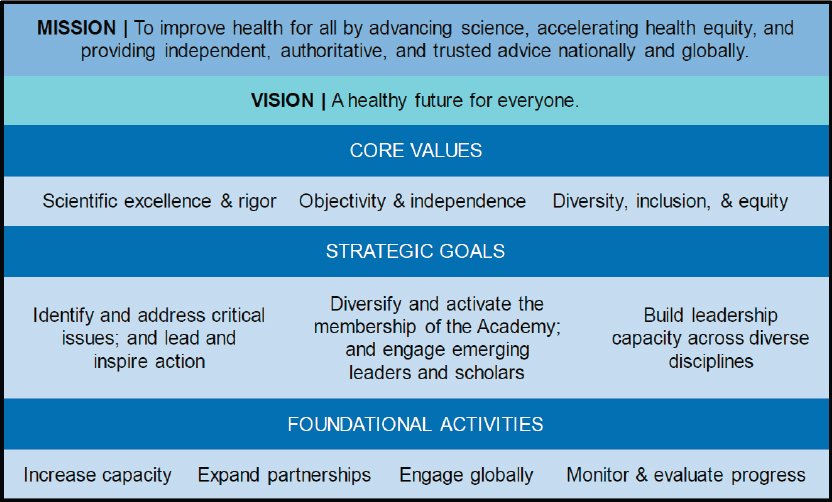
SOURCE: National Academy of Medicine.
Following the completion of the Strategic Plan, the NAM embarked on a 5-year implementation period, reporting progress to the NAM Council annually. Meanwhile, the NAM’s model was adapted by the NRC for its own strategic planning efforts, which were led by Dzau alongside National Academies’ leadership. In 2022, as the implementation period for the NAM Strategic Plan neared its conclusion, Dzau called for a review and refresh of the plan. At a meeting of the NAM Council in February 2022, many Councilors expressed that the fundamentals of the 2018–2023 plan remained relevant and adaptable to current and future priorities and did not require a complete overhaul.28
CONCLUSION
In a succinct statement of the NAM’s new programmatic approach, Dzau said that the Academy would explore “the space between knowledge and implementation” and build a nimble springboard from which to respond to urgent health crises. It would advise the nation and the world, serving to guide “the trajectory of health and health care in the United States and globally,” and build momentum around “big ideas” that would inspire the health community (Dzau, 2015a). The NAM developed innovative, action-oriented program models that differed significantly from the IOM’s approach and began to be adopted across the National Academies. Meanwhile, the ongoing working relationship between the NAM and the HMD sustained the legacy of the IOM and the vision of its founders.
___________________
28 NAM Council Minutes, February 8–9, 2022, IOM/NAM Records.
CHAPTER 3 APPENDIX FIGURES
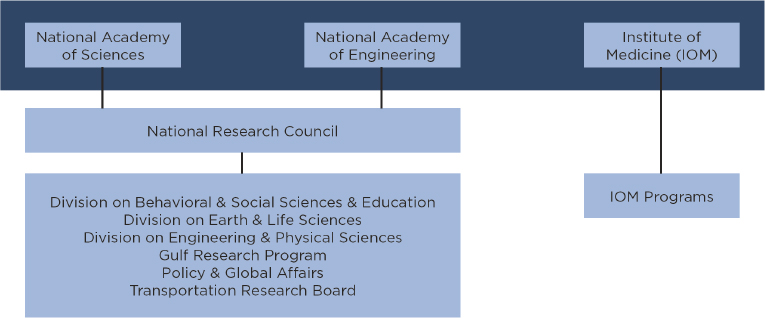
SOURCE: National Academy of Medicine.
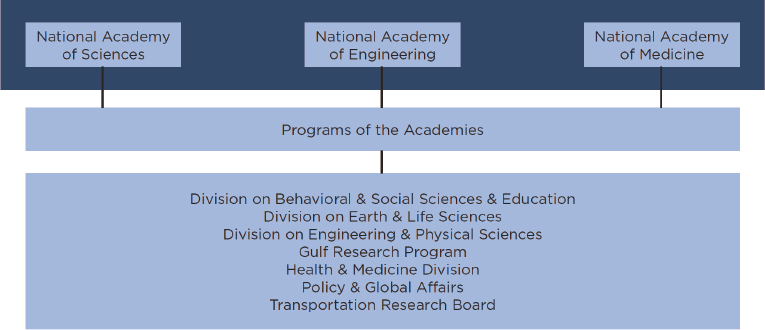
SOURCE: National Academy of Medicine.
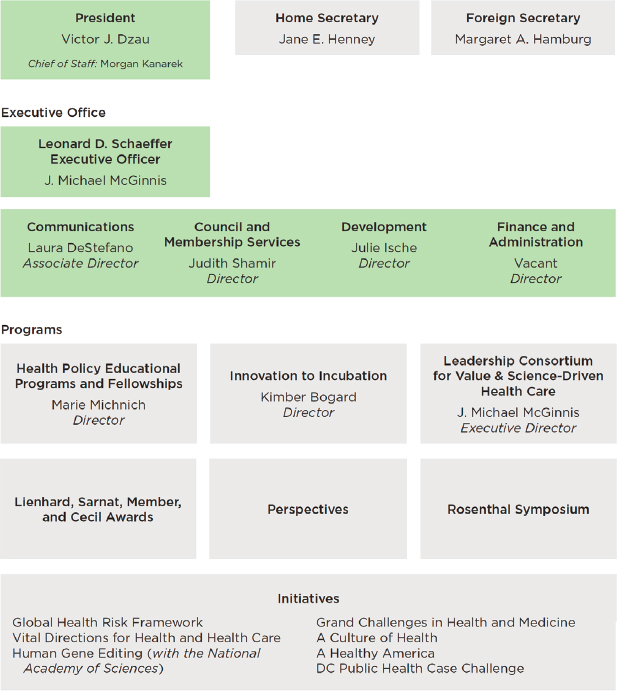
NOTE: This organizational chart shows the composition and staff of the NAM immediately following its reconstitution in July 2015, and is included as a snapshot of the new Academy at its inception.
SOURCE: National Academy of Medicine.
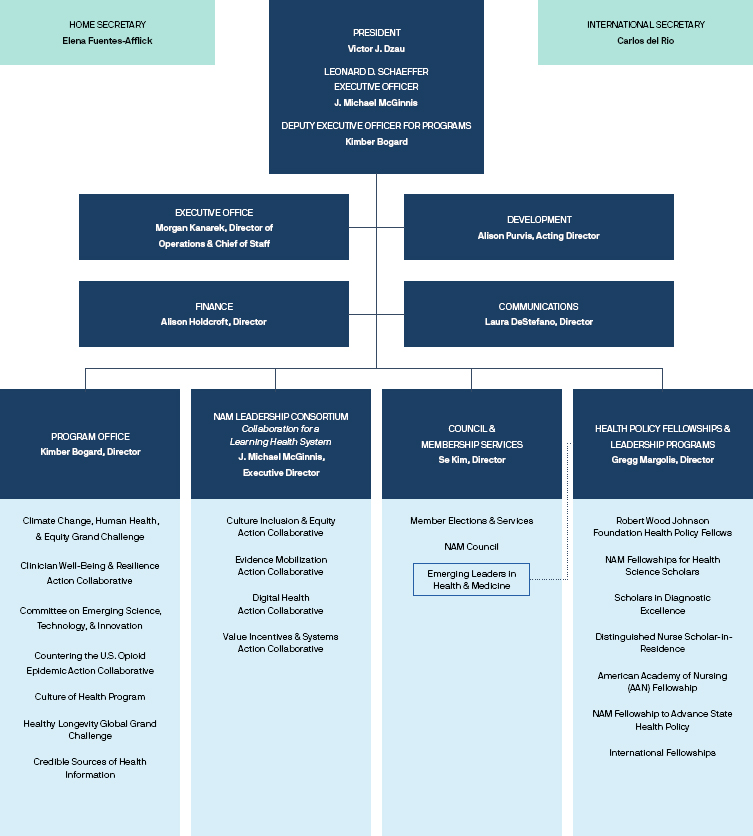
SOURCE: National Academy of Medicine.
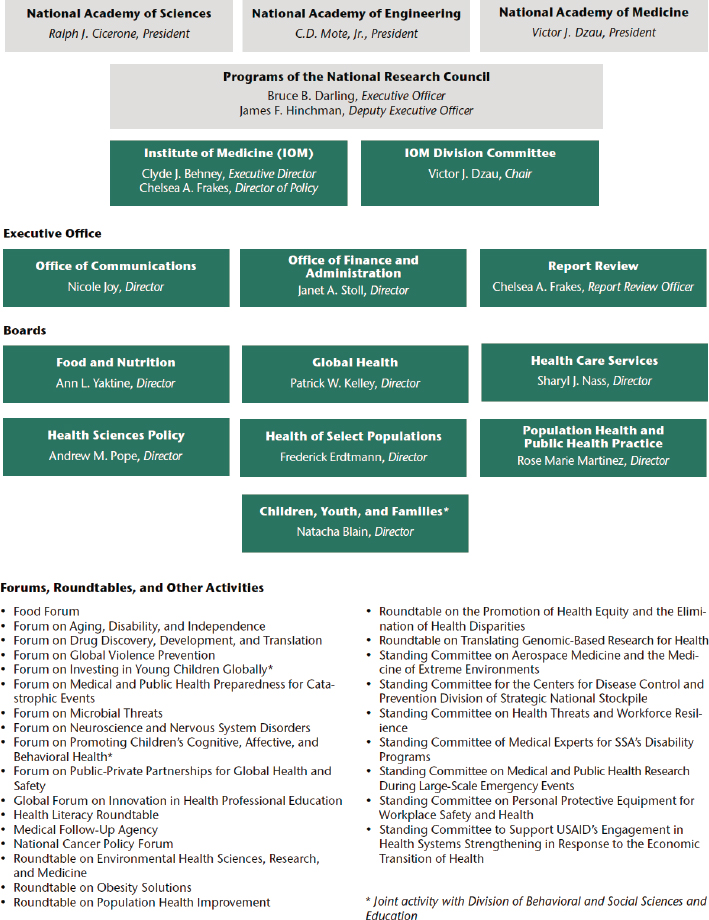
NOTES: This organizational chart shows the composition and staff of HMD immediately following its reconstitution in July 2015, and is included as a snapshot of the new division at its inception. To maintain continuity of the IOM brand following the reorganization, HMD was referred to as the “Institute of Medicine” until March 15, 2016.
SOURCE: National Academy of Medicine.
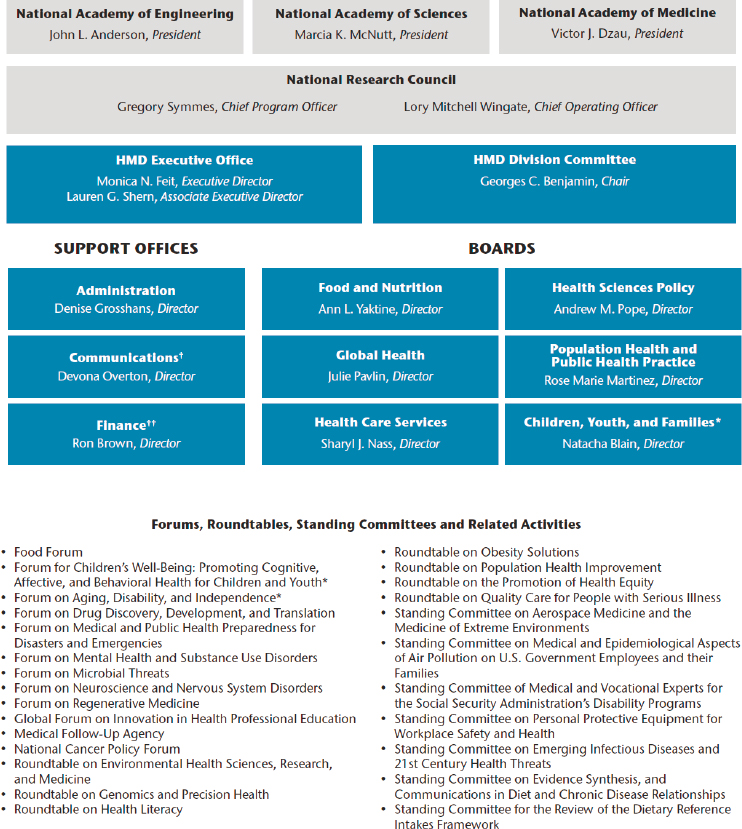
SOURCE: National Academy of Medicine.
This page intentionally left blank.


















